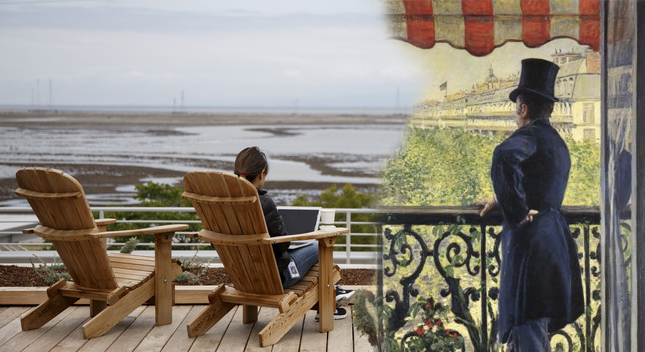
Facebook has made waves by building a 9-acre green roof on its new headquarters in Menlo Park, CA. The building was designed by Frank Gehry with CMG Landscape Architecture in charge of the roof, and opened this spring. An insider compared the green roof to the High Line, and while it does incorporate native plantings, provides meandering pathways, and is “entirely inspired by the regional landscape,” there are some glaring differences. For one, it is built atop new construction carved out of marshy salt flats, rather than on reclaimed-abandoned urban infrastructure. As much lip service as the referential new landscape pays to its surroundings, the building’s construction likely had some deleterious effect on the underlying saltwater marsh ecosystem it supplanted.
Another difference is that it is a private corporate environment, not a public space owned by a municipality and accessible to all, even if the space will be made available for community events on occasion. As much as Facebook seems like a public utility these days, it’s not. But the fanfare around the roof comes on the heels of France’s recent proclamation that all new commercial roofs have a green roof or solar panel component, and can work to enhance the profile of existing municipal experiments in North America, such as Chicago’s Green Rooftops program, D.C.’s, and that of the city of Toronto.
Green roofs can serve as another layer of hidden architectural infrastructure that serves to reduce heat island effects and runoff, or as experiential micro-parks, or both. They contribute to LEED certification, and also to WELL certification, “an evidence-based system for measuring, certifying, and monitoring the performance of building features that impact health and wellbeing.” Notably, green roofs only qualify under the outdoor biophilia category for WELL certification if the garden is accessible to building occupants.
The accessibility of Facebook’s roof by its workers is integral to its existence. The roof is an extension of the interior office space, a blurring of the line between work and relaxation: an on-site setting for company-provided breakfast, lunch, and dinner; naps; conversations; and walks that ultimately encourages employees to experience fleeting moments of escape without ever having to leave the building. The Facebook campus is conceived as an all-inclusive milieu for the dedicated employee, an enclosed habitat that is a sort of urban microcosm—complete with a tram, bike paths, restaurants, and a park—set in corporate suburbia. Seeing and being seen on the roof can allow the Facebook flâneur the appearance of simultaneously working and playing—perhaps playfully working, as is the norm in startup culture today—without skipping a beat. In this way, it serves the company as well as it aims to serve the employees. Make no mistake, beyond recreating migratory bird habitat along the Pacific Flyway, this is why it was included so prominently in the design.
Facebook has lifted a replicated environment seventy feet into the air and swept its new campus underneath in an effort to disappear into its surroundings much in the same way that the company pursues a seamless integration of work-life by providing all the extracurricular amenities an employee could want; and, on a larger scale, in parallel with its ambition to seamlessly integrate itself into every aspect of the media industry.
Coincidentally, last week saw the release of the Pope’s historic climate-themed encyclical, which takes aim at first-world consumption as a catalyst of climate change and is subtitled, “On Care For Our Common Home.” This common home is, of course, the planet—as literal as that is, it can seem so abstract when trying to comprehend our interconnectedness through time and space, on a global scale. However, the virtual ‘common home’ we have built on the internet is perhaps much more tangible to people, and certainly more accessible. Facebook, without a paywall and available to anyone on the web, is as much of a common home as Earth. Yet in the virtual world as in the analog one, consumption is what defines our experiences—of products, information, resources. Since the terra firma of the virtual world is not without its own, largely hidden, carbon footprint, the symbolism of its de facto headquarters’ eco-sensibility is ripe for interpretation.
In the meantime, I’ll just check out this topic now trending on Facebook about the 6th extinction that is upon us. Or, it was trending, last week. It now seems to have disappeared from my sidebar without a trace.